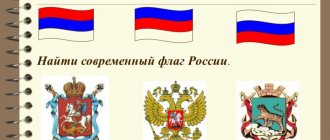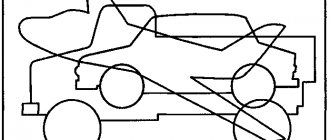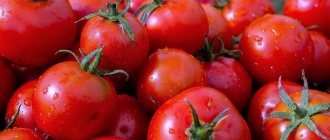Lesson summary, reflecting the specifics of work on the program for the formation of prepositional case forms.
The author presents a summary of the lesson, reflecting the specifics of the work on the program for the formation of prepositional-case constructions. This lesson illustrates the process of formation of integrative qualities of a preschooler according to FGT, in particular communicative ones - consolidation of prepositions with spatial meaning in auditory-speech and visual memory, development of inflection and word formation skills, coherent speech.
Topic: "Vegetables"
Target:
Strengthen the ability to use nouns in the prepositional case with the prepositions “in” and “on”
Tasks:
Communication development
- Differentiate the use of the prepositions “in” and “on”.
- Practically master the simplest methods of word formation by adding diminutive suffixes to nouns.
- Strengthen the ability to use verbs of the 1st person, present tense, indicative mood, singular.
- Development of the ability to compose a descriptive story using supporting diagrams.
Intellectual development
- Differentiate between vegetables that grow in the ground and vegetables that grow on the ground
- Teaching how to use the names of vegetables in active speech
- Develop sensory standards by relating vegetables to color and shape
- Develop voluntary attention and memory
Social and personal development
- Development of independence, discipline, accuracy
- Develop the ability to critically evaluate your own activities and the activities of others
- Develop the ability to work according to verbal instructions
Physical development
- Develop fine motor skills of fingers
- Develop spatial perception
Abstract “Vegetables. cooking vegetables"
• a statement of the main provisions of the new educational material that must be mastered by students (based on the content of this paragraph, the expert makes a judgment about the teacher’s level of proficiency in the subject material);
• description of forms and methods of presentation (presentation) of new educational material;
• description of the main forms and methods of organizing individual and group activities of students, taking into account the characteristics of the class in which the teacher works;
• description of the criteria for determining the level of attention and interest of students in the educational material presented by the teacher;
• description of methods of motivating (stimulating) students' educational activity during the development of new educational material.
Teacher:
Today we will talk about another product from which you can prepare various dishes. And what kind of product this is you will find out by solving the puzzle.
(A poster with a rebus hangs on the board
)
Teacher:
What word did we get?
Answer:
Vegetables.
Goal setting:
Teacher:
Right. And the topic of our lesson today is VEGETABLES. PREPARATION OF DISHES FROM RAW VEGETABLES. Open your notebooks and write down the date and topic of the lesson. Today we will talk about methods of primary processing and forms of cutting vegetables; what dishes can be prepared from raw and boiled vegetables; learn the technology of their preparation; Let's get acquainted with the methods of heat treatment of vegetables.
Presentation of new material.
1. Communication of educational information.
Presentation demonstration (slide No. 1-No. 3)
Students list vegetable plants they know. Name the parts ( organs)
) plants that are used for food.
The teacher summarizes the students' answers.
When using vegetables in cooking, a wide variety of cold and hot dishes are prepared from them: appetizers (salads, vinaigrettes), first courses (vegetable soup, cabbage soup, borscht, beetroot soup, etc.), second courses (fried or boiled potatoes, stew, cutlets). Vegetables are also used to prepare side dishes for fish and meat dishes and juices.
Vegetables have the ability to stimulate the activity of the salivary glands. Therefore, they are widely used for preparing cold appetizers - salads.
Vegetables, fruits and berries
contain a small amount of proteins and contain almost all the nutrients necessary for the body, being mainly carriers of minerals and plant fibers. Vegetables are especially rich in vitamins. Flavoring, coloring and aromatic substances contained in vegetables help stimulate appetite, better digestion of food and allow you to significantly diversify your diet. Vegetables have medicinal properties that are used in both traditional and scientific medicine. A number of vegetables contain special substances that can destroy some pathogenic microbes. Vegetables are used as dietary products for certain diseases.
Lesson summary “Fruits and vegetables”
Show a red square if you do not agree, green if you agree.— Do you believe that vitamins help children grow?
— Do you believe that plants and animals produce vitamins themselves?
— Do you believe that salad is a tasty and healthy dish?
— Do you believe that carrots used to be purple?
— Do you believe that tomatoes were previously considered poisonous?
I suggest you answer these same questions at the end of our lesson.
-You have a text on your tables. But the text has fallen into pieces; you need to arrange the parts of the text in the correct sequence.
What are vitamins? Vitamins are substances that help children grow strong and healthy. Both plants and animals can produce vitamins themselves, but humans cannot do this. Therefore, a person must receive vitamins from food.
Vitamins are called A, B, C.
Vitamin A helps us grow, not get sick, have strong teeth and good vision. Contained in cabbage, tomatoes, carrots, cucumbers.
Vitamin B helps us to be strong and have a good appetite. Use it if you don’t want to be upset and cry over trifles. Contained in beets, turnips, lettuce and apples, pears.
And vitamin C helps you catch colds less often, be cheerful, and recover faster from illness. Contained in onions, garlic, lemon, potatoes, oranges, bananas.
You need to eat a lot of vegetables and fruits!
Answer the questions:
-What are vitamins?
-How do you understand the meaning of the word “substance”?
— Read the fragment that talks about whether a person can produce vitamins himself?
-What vitamins are there?
— In order not to be upset over trifles, what vitamin does a person need?
- What vitamin helps us get better?
— What does vitamin A do?
-Do you agree with the author of this text?
— Tell me, what is the tastiest way to eat fruits and vegetables? (in ready meals)
- Great, today you will prepare salads. You are divided into 2 groups.
The first group will prepare a vegetable salad, and the second group will prepare a fruit salad.
I will give you the recipes, but unfortunately, the words from the recipe have spread. You will need to fill in the blanks.
Fruit salad recipe
Take 2 peaches
, 1
apple
, 1 orange and 2
bananas
.
Fruits
need to be washed.
Peel
the orange
and
banana Cut all the fruits into cubes. Season the salad with yogurt
. Ready!
Vegetable salad recipe
Take green onions
, 1
carrot
, 1
beet
, add parsley.
Vegetables
need to be washed.
Boil carrots
and
beets
, peel.
And cut everything into strips. Sprinkle lemon
juice and a couple of drops
of sunflower
oil. Ready!
Exercise 1
Find and read 5 words of fruit names. Insert a fruit that contains vitamin A into the recipe
apple pear peach
orange banana
Find and read 5 words of vegetable names. Insert a vegetable that contains vitamin C into the recipe.
turnip onion
tomatoescucumberscabbage
Previously, tomatoes were considered poisonous. In Rus', for some time, tomatoes were called “mad berries.”
Task 2
The word fell and shattered into pieces. Help me, put it together again from the letters. Write the word in the recipe.
ovmrok - carrots
olbkoya - apple
-Did you know that carrots were originally purple? And the carrot, in the form in which we are accustomed to seeing it, was bred in the fourteenth century in Holland using a mutation of the seeds of the African yellow carrot.
Task 3
Select the fruit/vegetable that is odd on this list. Add it to our recipe.
Banana
, apricot, orange, tangerine, grapefruit.
Beet
, cucumbers, zucchini, lettuce, peas.
-Why do you think he is superfluous?
But we still have gaps, let's fill them in by discussing it in the group.
-Now take a text highlighter and highlight all the ingredients in your recipe.
-All the necessary ingredients and put them in a plate. Take everything the recipe says!
-Now let's check each other. If you completed all the tasks correctly and were attentive, then you will get the right recipe and a delicious salad.
Summary of an integrated lesson on the topic “Vegetables”. Senior group with mental retardation
Summary of an integrated lesson on the topic “Vegetables”.
Senior group Goal: Clarification, expansion and consolidation of knowledge on the topic “Vegetables”. Objectives: 1. Correctional - educational:
Continue acquaintance with vegetables, form the concept of vegetables.
Clarification and activation of vocabulary on the topic. Develop the ability to independently apply your knowledge in practice. 2. Corrective and developmental:
Promote the activation, stimulation and exercise of visual functions, promote the development of visual perception and thought processes;
tactile perception. To promote the development of voluntary movements, orientation in space in relation to oneself and on a sheet of paper. 3. Educational:
Formation of skills of cooperation, interaction, independence and initiative. Cultivate interest in the classroom and respect for agricultural work.
Progress of the lesson
1. Outdoor game “Leaf” The wind is blowing, the breeze is blowing, A leaf fell from a tree, It flew, spun, and landed on the path. I bent down, picked up the sheet, and briskly walked into the group. Let him live in the group, Maybe he will grow up again. (Children with leaves approach the tree.) Working with the stand: - What color are the leaves on the tree? — Why are the leaves on the tree yellow? — What work do people do in the garden in the fall? -What do they collect? —Where do fruits grow? -Where do vegetables grow? 2. Game “Funny Vegetables” In autumn you can’t yawn, the harvest needs to be collected, the guys and I didn’t yawn, and we picked a basket full of vegetables. In our basket: Vegetables, carrots and vegetables, cabbage, Cucumber and tomatoes, Sweet peppers, very tasty. We have a vegetable garden, cabbage grows there, show us your vegetable and tell us about it. (Each child describes his own vegetable: color, shape, where it grows)
- Guys, what time of year is it now?
She just came to us, she brought riddles. 1. As I put on a hundred shirts, it crunched in my teeth (Cabbage). 2. I am growing in the ground in a garden bed, orange, long, sweet (Carrot). 3. The red, red fat man put his side up to the sun. look for him in the garden, he doesn’t like to play hide and seek (Tomato). 4. Fresh, green, and in winter – strong, salted in a barrel (Cucumbers). 5. The grandfather sits, dressed in a hundred fur coats, and whoever undresses him sheds tears (Luk). - You guessed the riddles, well done! “Now try to guess by touch what’s in these mysterious bags.” (Natural vegetables are used) 3. Game “Mystery bag” Find out by touch: tomato, cucumber, carrot, cabbage, beet. Children with their eyes closed take vegetables out of the bag and name them 4. Game “Find out the taste” 5. Game with a ball “What kind of juice” 1. Beetroot (beet); 2. Carrots (carrot); 3. Cucumber (cucumber); 4. Pumpkin (pumpkin); 5. Tomato (tomato). 6. Outdoor game “Vegetable Garden” Once a gray goat, (Index fingers are straightened, pointed to the forehead. Let’s go forward) He went into the garden to eat, and looked around. (We turn in one direction, then in the other direction.) There is food both here and there. Under the hooves there is grass, (We lower the chin) And above the head there is foliage. (Raise your chin) Bend over and eat the cabbage (Lean over) And at the top there are large pears (We stand on our toes and stretch) Cucumbers are growing behind us, (We turn back) The bushes are blooming in front (We go back) On the left is a young onion, (Half turns, right and left) On the right - delicious zucchini. The goat is spinning in place And while he was choosing, the Dog drove him into the barn. (Children quietly run into the office to sit on chairs) 7. Game “The Fourth Wheel” - Guys, where are the vegetables stored in the winter? - Today you and I must send vegetables in boxes to the vegetable storehouse, we need to check each box. (Each child comes up, makes his choice and explains) 8. Game “Match by Shape” Each child selects the desired geometric shape for the vegetable. 9. “Recognize by the outline” 10. “Color your vegetable” 11. Summary of the lesson Children hang their work on the “creativity wall”.
We recommend watching:
Summary of a lesson in the senior group with a compensatory focus for children with severe speech impairments Lesson on self-knowledge in the senior group Summary of educational activities in the senior group on the topic: “Expedition to the taiga” Summary of the lesson in the senior group on introducing children to the peoples of the Kama region
Similar articles:
Summary of a comprehensive lesson on familiarization with the outside world and development of speech “Wintering Birds” in the senior group of a preschool educational institution
Summary of an integrated lesson in the senior group on the topic: Russian nesting doll
Summary of a choreography lesson in the senior group
Summary of thematic music lesson in the senior group
Scenario for a musical themed lesson with preschoolers aged 5-6 years


